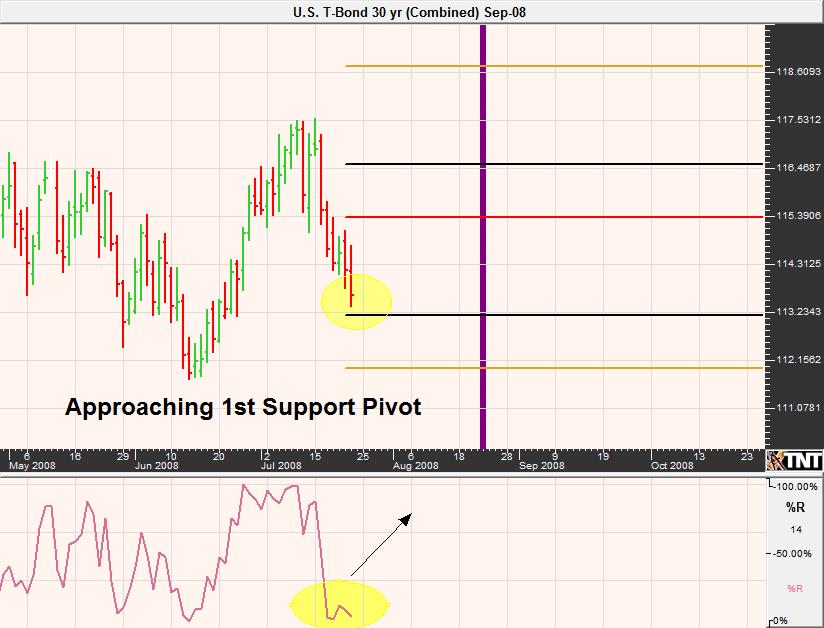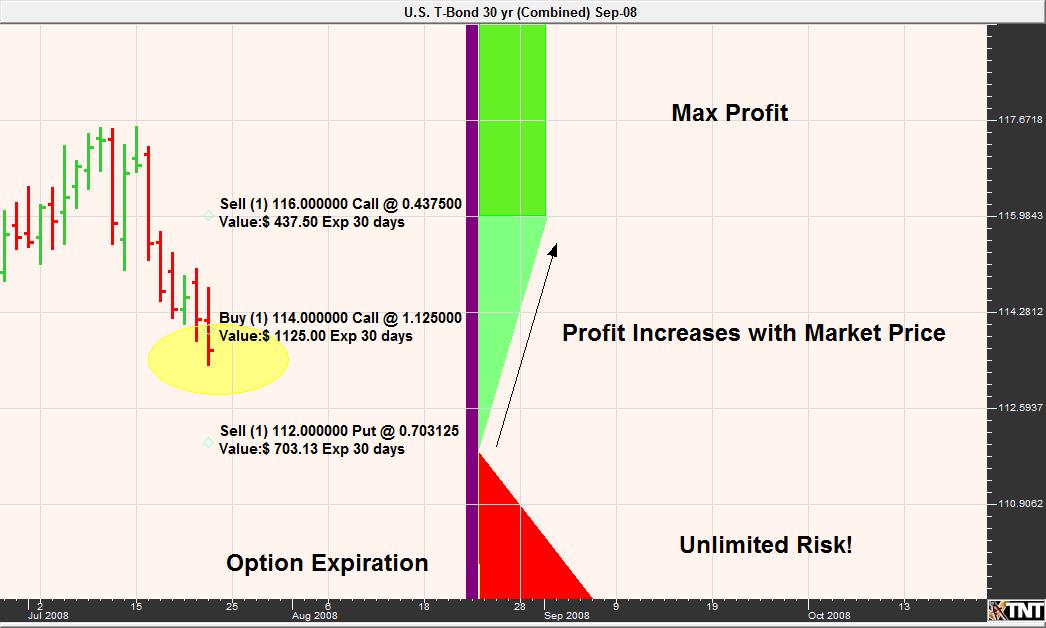How to Swing Trade with Options
Being privy to the options and futures markets along with trial and error has nurtured a respect and an in depth understanding of the markets. I hope that our readers will allow themselves to step out of the box when it comes to options trading and look toward the potential of trading aggressive options spreads.
Markets spend most of their time trading in a defined range; this makes profiting on long options strategies very difficult. Additionally, according to studies conducted by the CME, more options expire worthless than not. For these reasons a strict long options only tactic seems to have dismal odds. After all a long options play requires that the market make a substantial move in order to turn a profit to the trader and a range bound futures market likely won’t deliver.
Click here to learn how to utilize Bollinger Bands with a quantified, structured approach to increase your trading edges and secure greater gains with Trading with Bollinger Bands® – A Quantified Guide.
Within every trading range, there are brief trends in which some traders may look to profit from by buying or selling futures contracts. What most people don’t realize is that you can profit from a range bound market by using a combination of long and short options and futures.
While a swing trading strategy most often involves outright futures trading, I believe that options spread trading provides traders with a vehicle that is capable of mitigating some of the market’s volatility relative to going long or short a futures contract. Doing so allows more room for error should the market speculation be off in terms of direction or timing. In other words, an options spread affords traders the luxury of being less than perfect. As you can imagine, this has the potential of increasing the odds of success.
Keep in mind that once a futures position is executed, the trader is immediately exposed to unlimited risk and the profit and loss incurred becomes a reality. We will show you an alternative to futures trading that slows the pace of profit and loss but is capable of returning a respectable profit should the circumstances fit. As we cover an example, I hope that this concept will become clearer.
Naturally, if something seems too good to be true there will be a catch. The disadvantage of swing trading with options as opposed to futures contracts is the fact that the profit potential is often limited, but this depends on the structure of the trade. The example that we are about to cover does entail limited profit potential and unlimited risk.
Another negative aspect of aggressive options spread trading is the inability to actively trade in and out of a position without being able to overcome with transaction costs. These execution costs include both commission and the bid/ask spread paid to the executing broker. Additionally, short options can sometimes “get in the way” of your profitable long options.
Yet, these drawbacks shouldn’t discourage you from employing such a strategy. As you delve into this type of trading further, you will see that the same short options that limits your profit potential when things go right will cushion the blow when things go wrong. I strongly believe that if constructed properly and careful consideration is given to measures of volatility, a swing trading strategy using options provides traders with an aggressive vehicle that arguably provides better odds of success to a trader than an outright futures position.
Bull Call Spread with a Naked Leg
Buy Call A
Sell Call B (higher strike price)
Sell Put C
When to Use
- You think the market will go up, but purchasing a near-the-money outright call options position is very expensive
- The goal is to produce a very inexpensive or even free trade. A free trade occurs when you collect enough premium on the short legs of the spread to overcome most or all of the premium paid for the long legs. Keep in mind that the term free does not imply that there are no transactions costs, margin, or risk.
Profit Profile
- Profit is limited to the difference between the strike prices of the long and short call plus a net premium collected if executed as a credit
- At expiration the breakeven is equal to the long call strike price plus the net amount paid for the spread plus the transaction costs paid if executed as a debit
- BE = Long Strike Price + Net Premium Paid (if a debit) + Commissions and Fees
- RBE = Short Put Strike Price – Net Premium Collected (if a credit) + Commissions and Fees
What is the Risk?
- Risk on the downside (short put) is theoretically unlimited
- The market trading below the short put is equal to being long the futures from the put strike price
- At expiration if the market is between the short put and long call you lose the net paid for the spread if it was executed at a debit. If it was executed as a credit, the trader keeps the premium collected
Perhaps the bull call spread with a naked leg is best used in a situation in which going long a futures contract could be considered to be an attempt at “catching a falling knife”. In other words, if you are interested in a counter trend trade this may be the most efficient way to aggressively play the market. This is simply because the trade involves a long call in combination with a short call and a short put. If the futures market is trading wildly lower, you may be able to get the long call at a reduced price and collect top dollar for the short put.
Looking at the Figure (below), you can see that in late July 2008 the bond market had made a swift down move and was approaching the 1st level of pivot support. A trader without regard to risk management may simply buy a futures contract and hope for the best but a savvy trader may use a bull call spread. Doing so allows him to gain exposure to the market without jumping in front of the bus.
One version of a bull call spread with a naked leg would be to buy the September Treasury Bond 114 call and pay for it by selling the 116 call and the 112 put. Based on the theoretical values available to us, it may have been possible to execute the spread for a net credit of $15.63 before considering commissions and fees. The net credit is the result of collecting more premium for the short options than is paid for the long. Simply put, the market would have paid you a little over $15 to do this trade making the trade essentially free to execute. Please note that while this trade is ‘free’ in terms of out of pocket expense it still involves transaction costs, margin and unlimited risk below 112.
The maximum profit is equal to the distance between the long call and the short call plus the net credit and minus transaction costs and occurs if the futures price is above 116 at expiration. In this case it would be a little over $2,000 before commissions and fees.
The margin required on a trade like this varies and is based on an exchange owned software package known as SPAN (Standard Portfolio Analysis of Risk). However, given the distance from the market the margin on a trade like this is estimated to be about $1,000. Keep in mind that the margin can increase to an equivalent of the futures contract. This will typically occur if the futures price drops against the short put options.
Once again, the risk is unlimited below the strike price of the short put. For every tick that the futures price is below 112 at expiration, the trader is responsible. As you can imagine, if you are caught on the wrong side of a sharply declining market the losses can add up quickly. Thus, it is important that you imply proper risk management techniques.
Nonetheless, at any point above the short put strike price this trade has no risk. To put it directly, this trader could have been wrong in the direction of the bond market at expiration to the tune of 2 handles (the distance between 114 and 112) and still not incurred a loss on the trade ignoring transaction costs.
Because this trade was executed at a small credit, it will be profitable by the amount of the original credit ($15.63) with the futures at any point above 112. With the futures between 112 and 114, the trader simply gets to keep the premium collected. Above 114 the trade begins making money intrinsically until reaching its maximum potential at 116. Above 116 at expiration the trader doesn’t benefit from increases in market prices but does have the comfort in knowing that the maximum profit has been achieved.
Please note that this strategy and many others are expanded on in my book Commodity Options published by FT Press.
Conclusion
This article wasn’t meant to be a step by step instructional piece on options spread trading; instead the intention was to give you an overall idea of the possibilities that exist when being creative with options trading. There are an unlimited number of strategies and approaches to the market and which one works best for you is dependent on your personality and risk tolerance. Before you will be able to understand options trading, you must first understand yourself. Hopefully I have paved the way for you to explore your comfort levels by opening your mind to the alternatives.
Want more on this and other options strategies? Pick up a copy of Carley’s book Commodity Options: Trading and Hedging Volatility in the World’s Most Lucrative Market
published by FT Press, now available in all major book outlets.
Futures and Options Trade Involves Substantial Risk of Loss and is Not Suitable for All Investors.
Carley Garner is Senior Market Analyst and Broker with DeCarley Trading, and a columnist for Stocks and Commodities. The co-author of Commodity Options and author of the upcoming book, A Trader’s First Book on Commodities, Garner writes two widely-distributed e-newsletters, The Stock Index Report and The Bond Bulletin. She provides free trading education to investors at www.DeCarleyTrading.com. Garner is a Magna Cum Laude graduate of the University of Nevada Las Vegas.


